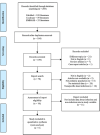Risk factors for cerebrospinal fluid shunt infection in pediatrics: A meta-analysis
- PMID: 39926462
- PMCID: PMC11799681
- DOI: 10.25259/SNI_848_2024
Risk factors for cerebrospinal fluid shunt infection in pediatrics: A meta-analysis
Abstract
Background: Placement of cerebrospinal fluid (CSF) shunt for diversion remains a primary treatment for patients with hydrocephalus despite its surgical complications, including shunt infection, that remain high and become a medical and social problem. The meta-analysis was conducted to investigate risk factors of shunt infection in pediatrics.
Methods: Literature was searched on PubMed, Scopus, and the Cochrane Library. The methodology used for this investigation was preferred reporting items for systematic reviews and meta-analysis.
Results: This meta-analysis included five publications. The only significant results were found in ages <6 months with relative risk (RR) of 33.06 (95% confidence interval [CI] 9.27-117,99; P < 0.01), Caucasian race with RR of 15.24 (95% CI 6.77-34.34), and African-American race with RR of 2.37 (95% CI 2.07-2.70). The other results provided were not significant, such as intraventricular hemorrhage (IVH) of prematurity as the etiology of hydrocephalus with RR of 4.71 (95% CI 1.07-20.82), presence of gastrostomy during shunt insertion with RR of 3.80 (95% CI 0.91-15.88), and comorbidity of respiratory diseases with RR of 0.22 (95% CI 0.11-0.43).
Conclusion: Younger age during the shunt placement procedure, Caucasian race, and African-American race have a significantly higher risk of CSF shunt infection. The previously reported higher risk of shunt infection in cohort studies, such as IVH of prematurity and the presence of gastrostomy, were not significant in this study. Primary studies regarding shunt infection are advocated to be performed in a more extensive population with further risk factors included in the analysis.
Keywords: Hydrocephalus; Pediatrics; Risk factors; Shunt infection.
Copyright: © 2025 Surgical Neurology International.
Conflict of interest statement
There are no conflicts of interest.
Figures







Similar articles
-
To shunt or not to shunt when closing myelomeningocele? A systematic review and meta-analysis of simultaneous versus delayed ventriculoperitoneal shunt placement in neonates undergoing myelomeningocele closure.J Neurosurg Pediatr. 2024 Aug 9;34(5):452-461. doi: 10.3171/2024.5.PEDS23600. Print 2024 Nov 1. J Neurosurg Pediatr. 2024. PMID: 39126714
-
Factors associated with early shunt revision within 30 days: analyses from the National Surgical Quality Improvement Program.J Neurosurg Pediatr. 2021 Oct 8;29(1):21-30. doi: 10.3171/2021.7.PEDS21222. Print 2022 Jan 1. J Neurosurg Pediatr. 2021. PMID: 34624850
-
Shunting outcomes in posthemorrhagic hydrocephalus: results of a Hydrocephalus Clinical Research Network prospective cohort study.J Neurosurg Pediatr. 2017 Jul;20(1):19-29. doi: 10.3171/2017.1.PEDS16496. Epub 2017 Apr 28. J Neurosurg Pediatr. 2017. PMID: 28452657
-
Surgical management of hydrocephalus secondary to intraventricular hemorrhage in the preterm infant.J Neurosurg Pediatr. 2016 Mar;17(3):278-84. doi: 10.3171/2015.6.PEDS15132. Epub 2015 Nov 13. J Neurosurg Pediatr. 2016. PMID: 26565942
-
Neurodevelopmental outcomes after ventriculoperitoneal shunt placement in children with non-infectious hydrocephalus: a meta-analysis.Childs Nerv Syst. 2021 Apr;37(4):1055-1065. doi: 10.1007/s00381-021-05051-9. Epub 2021 Jan 21. Childs Nerv Syst. 2021. PMID: 33479825 Review.
References
-
- Alvi MA, Bhandarkar AR, Daniels DJ, Miller KJ, Ahn ES. Factors associated with early shunt revision within 30 days: Analyses from the National Surgical Quality Improvement Program. J Neurosurg Pediatr. 2022;29:21–30. - PubMed
-
- Beckman JM, Amankwah EK, Tetreault LL, Tuite GF. Reduction in CSF shunt infection over a 10-year period associated with the application of concentrated topical antibiotic powder directly to surgical wounds prior to closure. J Neurosurg Pediatr. 2015;16:648–61. - PubMed
-
- Champeaux-Depond C, Ramasy Razafindratovo RM, Chevret S. Gastrostomy and internal cerebrospinal fluid shunt in adults. A systematic review and meta-analysis of the risk of infection. Neurochirurgie. 2022;68:e75–83. - PubMed
LinkOut - more resources
Full Text Sources
